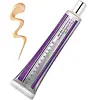What's inside
What's inside
 Key Ingredients
Key Ingredients

No key ingredients
 Benefits
Benefits

 Concerns
Concerns

 Ingredients Side-by-side
Ingredients Side-by-side

Water
Skin ConditioningHydrogenated Polydecene
EmollientGlycerin
HumectantMethyl Gluceth-20
HumectantGlycol
HumectantDiglycerin
HumectantOctyldodecanol
EmollientCitrus Aurantium Amara Flower Extract
RefreshingChlorphenesin
AntimicrobialButylene Glycol
HumectantCaprylyl Glycol
EmollientCarbomer
Emulsion StabilisingPolyhydroxystearic Acid
EmulsifyingDisteardimonium Hectorite
StabilisingPolyglycerin-3
HumectantTamarindus Indica Seed Gum
Emulsion StabilisingTrisodium Ethylenediamine Disuccinate
Aluminum Hydroxide
EmollientPropylene Carbonate
SolventAmodimethicone
Sodium Hydroxide
BufferingSodium Lauroyl Glutamate
Alcaligenes Polysaccharides
EmollientParfum
MaskingLysine
Skin ConditioningGlucose
HumectantMagnesium Chloride
Ultramarines
CI 77491
Cosmetic ColorantCI 77492
Cosmetic ColorantCI 77499
Cosmetic ColorantCI 77891
Cosmetic ColorantMica
Cosmetic ColorantWater, Hydrogenated Polydecene, Glycerin, Methyl Gluceth-20, Glycol, Diglycerin, Octyldodecanol, Citrus Aurantium Amara Flower Extract, Chlorphenesin, Butylene Glycol, Caprylyl Glycol, Carbomer, Polyhydroxystearic Acid, Disteardimonium Hectorite, Polyglycerin-3, Tamarindus Indica Seed Gum, Trisodium Ethylenediamine Disuccinate, Aluminum Hydroxide, Propylene Carbonate, Amodimethicone, Sodium Hydroxide, Sodium Lauroyl Glutamate, Alcaligenes Polysaccharides, Parfum, Lysine, Glucose, Magnesium Chloride, Ultramarines, CI 77491, CI 77492, CI 77499, CI 77891, Mica
Water
Skin ConditioningCyclopentasiloxane
EmollientButylene Glycol
HumectantNeopentyl Glycol Diethylhexanoate
EmollientTalc
AbrasiveGlycerin
HumectantPEG-10 Dimethicone
Skin ConditioningDimethicone
EmollientPhenyl Trimethicone
Skin ConditioningPentylene Glycol
Skin ConditioningPEG-150
HumectantMagnesium Sulfate
Aluminum Hydroxide
EmollientStearic Acid
CleansingSilica Dimethyl Silylate
EmollientDimethicone/Vinyl Dimethicone Crosspolymer
Skin ConditioningMica
Cosmetic ColorantPhenoxyethanol
PreservativeTrimethylsiloxysilicate
EmollientDextrin Palmitate
EmulsifyingTocopherol
AntioxidantAlcohol
AntimicrobialRosa Damascena Flower Water
MaskingLeontopodium Alpinum Flower/Leaf Extract
Skin ConditioningThymus Vulgaris Flower/Leaf Extract
MaskingBuddleja Davidii Extract
Skin ConditioningCamellia Sinensis Leaf Extract
AntimicrobialChondrus Elatus/Saccharina Angustata/Monostroma Nitidum Thallus Extract
Skin ConditioningLonicera Japonica Flower Extract
Skin ConditioningGlycine Soja Protein
EmulsifyingSodium Dextran Sulfate
Gel FormingSuperoxide Dismutase
AntioxidantSodium Benzoate
MaskingEthylhexylglycerin
Skin ConditioningPotassium Sorbate
PreservativeCI 77891
Cosmetic ColorantIron Oxides
Water, Cyclopentasiloxane, Butylene Glycol, Neopentyl Glycol Diethylhexanoate, Talc, Glycerin, PEG-10 Dimethicone, Dimethicone, Phenyl Trimethicone, Pentylene Glycol, PEG-150, Magnesium Sulfate, Aluminum Hydroxide, Stearic Acid, Silica Dimethyl Silylate, Dimethicone/Vinyl Dimethicone Crosspolymer, Mica, Phenoxyethanol, Trimethylsiloxysilicate, Dextrin Palmitate, Tocopherol, Alcohol, Rosa Damascena Flower Water, Leontopodium Alpinum Flower/Leaf Extract, Thymus Vulgaris Flower/Leaf Extract, Buddleja Davidii Extract, Camellia Sinensis Leaf Extract, Chondrus Elatus/Saccharina Angustata/Monostroma Nitidum Thallus Extract, Lonicera Japonica Flower Extract, Glycine Soja Protein, Sodium Dextran Sulfate, Superoxide Dismutase, Sodium Benzoate, Ethylhexylglycerin, Potassium Sorbate, CI 77891, Iron Oxides
 Reviews
Reviews

Ingredients Explained
These ingredients are found in both products.
Ingredients higher up in an ingredient list are typically present in a larger amount.
Aluminum Hydroxide is a form of aluminum. It can be naturally found in nature as the mineral gibbsite. In cosmetics, Aluminum Hydroxide is used as a colorant, pH adjuster, and absorbent.
As a colorant, Aluminum Hydroxide may add opacity, or reduce the transparency. Aluminum hydroxide is contains both basic and acidic properties.
According to manufacturers, this ingredient is an emollient and humectant. This means it helps hydrate the skin.
In medicine, this ingredient is used to help relieve heartburn and help heal ulcers.
There is currently no credible scientific evidence linking aluminum hydroxide in cosmetics to increased cancer risk.
Major health organizations allow the use of aluminum hydroxide in personal care products and have not flagged it as a carcinogenic risk at typical usage levels.
Learn more about Aluminum HydroxideButylene Glycol (or BG) is used within cosmetic products for a few different reasons:
Overall, Butylene Glycol is a safe and well-rounded ingredient that works well with other ingredients.
Though this ingredient works well with most skin types, some people with sensitive skin may experience a reaction such as allergic rashes, closed comedones, or itchiness.
Learn more about Butylene GlycolCi 77891 is a white pigment from Titanium dioxide. It is naturally found in minerals such as rutile and ilmenite.
It's main function is to add a white color to cosmetics. It can also be mixed with other colors to create different shades.
Ci 77891 is commonly found in sunscreens due to its ability to block UV rays.
Learn more about CI 77891Glycerin is already naturally found in your skin. It helps moisturize and protect your skin.
A study from 2016 found glycerin to be more effective as a humectant than AHAs and hyaluronic acid.
As a humectant, it helps the skin stay hydrated by pulling moisture to your skin. The low molecular weight of glycerin allows it to pull moisture into the deeper layers of your skin.
Hydrated skin improves your skin barrier; Your skin barrier helps protect against irritants and bacteria.
Glycerin has also been found to have antimicrobial and antiviral properties. Due to these properties, glycerin is often used in wound and burn treatments.
In cosmetics, glycerin is usually derived from plants such as soybean or palm. However, it can also be sourced from animals, such as tallow or animal fat.
This ingredient is organic, colorless, odorless, and non-toxic.
Glycerin is the name for this ingredient in American English. British English uses Glycerol/Glycerine.
Learn more about GlycerinMica is a naturally occurring mineral used to add shimmer and color in cosmetics. It can also help improve the texture of a product or give it an opaque, white/silver color.
Serecite is the name for very fine but ragged grains of mica.
This ingredient is often coated with metal oxides like titanium dioxide. Trace amounts of heavy metals may be found in mica, but these metals are not harmful in our personal products.
Mica has been used since prehistoric times throughout the world. Ancient Egyptian, Indian, Greek, Roman, Aztec, and Chinese civilizations have used mica.
Learn more about MicaWater. It's the most common cosmetic ingredient of all. You'll usually see it at the top of ingredient lists, meaning that it makes up the largest part of the product.
So why is it so popular? Water most often acts as a solvent - this means that it helps dissolve other ingredients into the formulation.
You'll also recognize water as that liquid we all need to stay alive. If you see this, drink a glass of water. Stay hydrated!
Learn more about Water